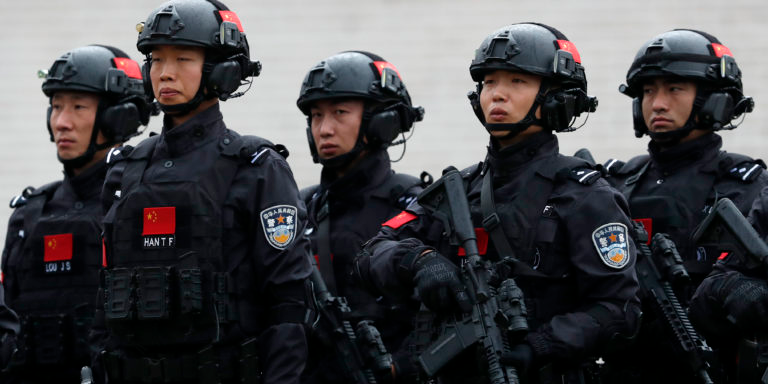China has made inroads in Central Asia to secure economic, energy, and security interests, bringing with it a host of consequences for the region.
China influences regional security through the Shanghai Cooperation Organization (SCO) and its Regional Anti-Terrorist Structure (RATS).
China’s security footprint in Central Asia continues to expand, growing beyond the SCO in an attempt to broaden its security engagement.
Beijing’s activities impact the security and stability of the region, with implications for geopolitics, domestic stability, and human rights.
China views Central Asia—Kazakhstan, Kyrgyzstan, Tajikistan, Turkmenistan, and Uzbekistan—as a key region to secure Beijing’s growing economic, energy, and security interests. The region serves as the gateway to the Eurasian continent and as a significant node in President Xi Jinping’s signature foreign policy enterprise, the Belt and Road Initiative (BRI). China has been the largest trading partner for Uzbekistan since 2015 and a key investor in Tajikistan—accounting for 77% of foreign direct investment in the country in 2018. Energy infrastructure, like the Central Asia-China gas pipeline, also aids Beijing in its quest for energy diversification and security. According to Chinese state media, 15% of all natural gas consumed by China in 2019 was imported from Turkmenistan, Uzbekistan and Kazakhstan. Stability and security in Central Asia is not only important to assure economic and strategic interests, but also to safeguard against potential spillover from Afghanistan—including terrorism and political instability—that could destabilize China’s West. To safeguard against such disruption, China has actively increased its profile as a key security player in Central Asia, using the rubric of counterterrorism.
China’s security footprint in Central Asia has principally been established through the Shanghai Cooperation Organization (SCO). Founded in 2001 as a successor to the “Shanghai Five,” the SCO is a multilateral forum with a primary objective of security-related cooperation among members; this is utilized especially for what China deems as the fight against the “three evils”—terrorism, separatism, and religious extremism. The SCO’s counterterrorism initiatives are largely channeled through the Regional Anti-Terrorist Structure (RATS). The SCO, however, has also served to increase Chinese diplomatic engagement, intelligence sharing, and power projection in Central Asia. Between 2003 and 2016, China held 102 meetings with Central Asian senior defense officials. In 2018, during the SCO Qingdao summit, new policies were introduced that were intended to increase intelligence sharing and facilitate extraditions between member states based on terrorism grounds. Through the SCO, China has participated in 10 joint exercises in Central Asia between 2002 and 2019—exercises that help Chinese security forces gain crucial operational experience and project power and influence far beyond China’s borders. Over the past two years, China has also been increasingly proactive on counterterrorism issues at the United Nations; though a permanent member of the Security Council, China has not traditionally led new policy initiatives on counterterrorism in that venue. However, in September 2019, the UN Security Council hosted a debate on the contribution of the Collective Security Treaty Organization, Commonwealth of Independent States, and Shanghai Cooperation Organization in countering terrorist threats. In March 2020, it was China that spearheaded a Security Council Presidential Statement on terrorism in Africa, drawing on their extensive development investments and security interests in the continent. These are reflective of more proactive Chinese engagement in multilateral organizations more broadly, where Western powers have traditionally dominated the counterterrorism and security space.
In recent years, China’s security inroads in Central Asia have broadened in scope as well as practice, expanding beyond the SCO and counterterrorism as vehicles for security engagement within the region. China’s security activities in Central Asia include: joint multi-and bi-lateral training, drills, and exercises for military and security forces, weapons and military technology sales, capacity building, military diplomacy, a military outpost, joint border operations, and the use of private security contractors. Between 2014 and 2019, China has conducted at least 10 bilateral military exercises with Central Asian countries. Since 2016, the People’s Armed Police of China has operated a military outpost in the Gorno-Badakhshan Autonomous Region on the Tajik-Afghan border. In 2014, China provided Kyrgyzstan with $16 million in military aid, and two years later, pledged assistance to Tajikistan to build 11 border posts along the Afghan-Tajik border. By 2019, Zhongjun Junhong, a Chinese private security contractor, had secured contracts with over 20 Chinese clients operating in Kyrgyzstan, including state owned enterprises like the China Road and Bridge Corporation.
Paradoxically, Beijing’s activities in Central Asia have notable consequences for stability in the region. Russia considers the Central Asian states within its historical sphere of influence, and while Moscow’s economic clout is dwarfed by Beijing’s, the former is still the predominant security guarantor of the region—including through the Collective Security Treaty Organization (CSTO). China’s security inroads in Russia’s backyard were initially pursued through multilateral engagements that included Moscow and focused on the mutual security interest of counterterrorism. This common objective also allowed the UN’s Regional Center for Counter-Terrorism (UNRCCA) to do some regional work on counterterrorism, mostly to try and promote regional dialogue against the backdrop of strong regional sensitivities. The observed shifts in China’s security engagement with Central Asia in recent years, however, may provide grounds for geopolitical competition between the two powers. In addition, documented anti-Chinese sentiment in Central Asia has been further exacerbated by China’s genocide in Xinjiang—some of whom are Central Asian nationals. Such grassroots sentiments may cause increased civil unrest in Central Asian countries, as well as violent attacks targeting Chinese nationals and infrastructure. Such acts could lead Beijing to push for a greater Chinese security presence in the region, as it has done in Pakistan.
Lastly, China’s security cooperation with Central Asian countries has been criticized for exercising political oppression in the name of combating terrorism. The mass incarceration of ethnic Uighurs, reports of forced labor and rape, and the destruction of Uighur Muslim monuments and mosques has led to widespread international condemnation of such human rights abuses, and their perpetration under the guise of terrorism prevention. To this end, Beijing has claimed to be concerned about terrorism from the Eastern Turkistan Independence Movement (ETIM) and the prospect of radicalization and separatist violence in the province of Xinjiang. As China’s security footprint in the region expands, including through the export of surveillance technology, it has the potential to aid the strengthening of authoritarianism in the region, a concern for the United States.
 Eurasia Press & News
Eurasia Press & News




